Indoor air quality has become a household term during COVID-19 and for good reason. Poorly ventilated spaces are at the highest risk for a COVID-19 outbreak – making clean, safe air more important than ever. As schools reopen and look to places like the CDC for guidelines on building safety, it is critical that addressing air quality is at the top of the list.
Navigating research, technical documentation and scientific studies can be time-consuming, and having confidence in your decisions can be difficult. That’s why the qlair team put together a list of 10 ventilation and air filtration strategies you can trust to add safety to your school reopening plan:
1. Ensure ventilation systems operate properly to provide clean air
- Increase total airflow supply to occupied spaces, when possible.
- Disable demand-controlled ventilation (DCV) controls that reduce air supply based on occupancy or temperature during occupied hours.
2. Run inspections and consider trying new ways to ensure clean air
- Ensure restroom exhaust fans are functional and operating at full capacity when the school is occupied.
- Inspect and maintain local exhaust ventilation in areas such as restrooms, kitchens, cooking areas, etc.
- Consider running the HVAC system at maximum outside airflow for 2 hours before and after the school is occupied.
3. Initiate an Indoor Air Quality project with experts in the field
The only way of knowing what strategies will provide your students and staff with continuous clean air is to gather data on your indoor environment. Indoor air quality monitoring is becoming a widely-accepted aspect of building operations, and offers a wealth of benefits for occupants and building efficiency alike.
If you work with a partner like qlair, the process will look something like this:
- Installing a network of RESET-certified sensors that track the most important air quality parameters for occupant well-being and building performance.
- Monitoring trends in air quality over time, leverage powerful machine-learning to get data and insights straight to a smartphone app and web dashboard.
- Making informed decisions on how to mitigate air quality issues as they arise, then testing the effectiveness of the solution selected.
4. Increase outdoor air ventilation, using caution in highly polluted areas
When weather conditions allow, increase fresh outdoor air by opening windows and doors. Use fans to increase the effectiveness of open windows. Position fans securely and carefully in or near windows so as not to induce potentially contaminated airflow directly from one person over another. Decrease occupancy where ventilation cannot be increased.
5. Attempt to reduce or eliminate HVAC air recirculation
Further open minimum outdoor air dampers to control fresh air levels inside. In mild weather, this will not affect comfort or humidity. However, this may be difficult to do in cold, hot, or humid conditions.
6. Improve central air filtration to maximize removal efficiency

- Increase air filtration grade to as high as possible without significantly diminishing design airflow.
- Inspect filter housing and racks to ensure appropriate filter fit and check for ways to minimize filter bypass
- Check filters to ensure they are within service life and appropriately installed.
7. Leverage air purification and disinfection technology for added precaution
Use portable high-efficiency particulate air (HEPA) fan/filtration systems to help enhance air cleaning (especially in higher risk areas such as the nurse’s office).
Consider using ultraviolet germicidal irradiation (UVGI) as a supplement to help inactivate SARS-CoV-2, especially if options for increasing room ventilation are limited.
Contact us to learn more about indoor air quality solutions for your education facility.



